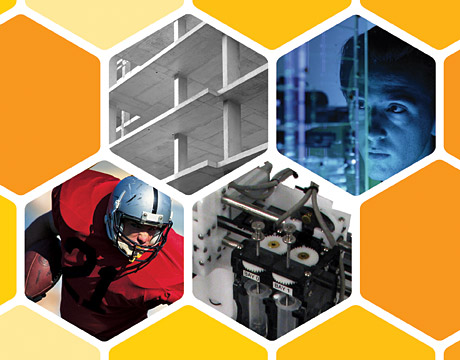3D Printed Material Saves Energy
3D Printed Material Saves Energy


A collaboration between Purdue University and General Motors is aimed at developing a new type of energy-absorbing material that will provide better impact protection from various forces. The new material, which the research team is calling phase-transforming cellular materials, or PXCMs, can be scaled to almost any size and 3D printed.
These capabilities offer promise for a less expensive alternative for a broad range of applications from football helmets to components of building materials that could be used to lessen the destructive impact to buildings in earthquake and major storm-prone areas.
The work is being conducted by the research group of Pablo Zavattieri, associate professor in Purdue’s Lyles School of Civil Engineering and a University Faculty Scholar at Purdue; a postdoc in his lab, David Restrepo; and Nilesh D. Mankame from the Smart Materials & Structures Group at GM’s Global Research & Development Center. Studying, designing, and analyzing innovative cellular materials, the team spends time fabricating, modeling, performing experiments, and working with analytical models describing the behavior of the materials.
The collaboration with GM, where Zavattieri spent eight years working on other “smart” materials as a staff researcher prior to joining Purdue in 2009, is viewed as a way to assure that the work is relevant to industry needs, according to Purdue’s application for a National Science Foundation grant, which it was awarded last [2015] year.
“I have been working with GM since 2010. This is a natural continuation of that work,” Zavattieri says.
Earlier, Boeing’s HRL Laboratories announced the development of the “world’s lightest metal,” a 3D printed microlattice material that also has high shock absorption properties. The work at Purdue/GM goes a step further in creating the scalable material with a honeycomb-like cellular design. The structure can have two stable positions and can remain in either position indefinitely, says Zavattieri.
A paper authored by the three team members describing the latest developments in “Extreme Mechanics Letters,” published last September, states that they introduced a new class of cellular materials. The material, which can be made of metal or polymer or essentially any material that behaves elastically, is also re-usable because after absorbing energy it is not damaged and can be re-set to its original configuration, according to Zavattieri.
More importantly, says Restrepo, “Our results have shown that PXCMs can perform similarly to commercial metallic cellular structures used for energy dissipation without relying on plastic deformation.”
Despite the breakthroughs in the early research stage, the project is considered to be in the proof-of-concept phase. “We are still facing many challenges,” Zavattieri says. “The biggest challenge is understanding the design and mechanics of this material in order to be able to explain the phenomenon. We are spending a lot of time understanding the physics and how to model the material and trying to extend these concepts to other materials. We are learning something new about this material every day.”
Among the near-term objectives are developing more models and designing other materials that can be activated in 3D, he says.
In an article on the Purdue website, Mankame notes, “Many emerging materials like aluminum, magnesium, and fiber-reinforced composites that play an increasingly important role in the transportation, defense and construction industries suffer from low intrinsic energy dissipation. The energy absorption capability of structures that are made of such base materials can be increased by incorporating PXCMs into the structures. [This] makes it possible for engineers to integrate energy absorption as a secondary function into structures that are already in use.”
At the same time, the team is exploring what might be the best applications and how it would be applied for initial studies. “We are very close into looking into specific applications,” Zavattieri says, adding that one consideration will be from what industry funding will come.
Also still to be conducted are feasibility studies to determine the right combination of materials and geometries needed for each application. “We are also thinking about protecting system parts. If we want to protect something, then what are the properties we want from this material,” he says.
Nancy S. Giges is an independent writer.
Learn about the latest energy solutions at ASME’sPower & Energy Conference and Exhibition.
The biggest challenge is understanding the design and mechanics of this material [PXCMs] in order to be able to explain the phenomenon. We are learning something new about this material every day.Prof. Pablo Zavattieri, Purdue University



